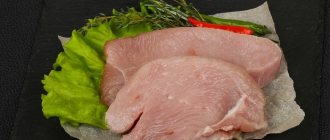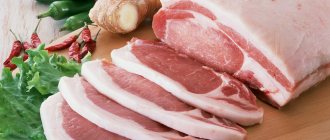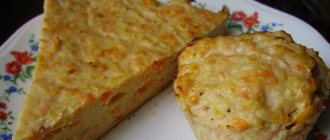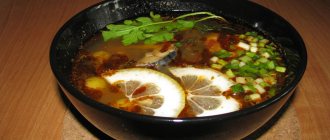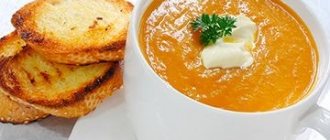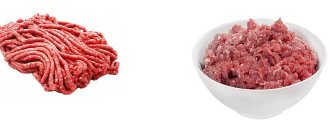Nutritional value
The largest amount of white meat pulp is found in chicken breast. You can make many different dishes from it - tasty and easy to prepare. Together with chicken meat, our body receives the necessary nutrients, without which a full-fledged human existence is impossible.
- Most essential amino acids enter the body only with food, since the body is unable to reproduce them on its own. Doctors and nutritionists consider two amino acids out of the twelve that are contained in chicken meat to be especially valuable. The first is tryptophan, which is involved in the synthesis of the hormone serotonin, which is responsible for human wakefulness, as well as for calm and sound sleep. And the second essential amino acid is called lysine and is a building material for muscle tissue, as well as a strategic reserve of strength and energy for human life.
- Nine nonessential amino acids that are involved in all biological processes in the body. Particularly important among them is arginine, whose mission is to maintain the working condition of joints and help them recover from injuries.
- Unsaturated fatty acids that help the body rebuild and adapt to heavy physical activity.
- Polyunsaturated fatty acids Omega-3 and Omega-6, which are responsible for the condition of the skin, hair, nails, and have a beneficial effect on mental activity and performance.
- Omega-9 monounsaturated acid, which resists cancer and inflammatory processes.
- Vitamins of group A, B, C, PP, H, which play an important role in the proper functioning of the cardiovascular and digestive systems, are involved in water-salt metabolism, and strengthen the body’s immunity.
- Valuable minerals: iron, selenium, zinc, magnesium, copper, chlorine, sodium, phosphorus are important components in many biochemical reactions and physiological processes in the body. Without them, human growth and full development is impossible.

Calorie content
Chicken breast is a product known for its low calorie content. It contains only 113 kcal of energy per 100 grams of product. The components of BJU have the following indicators per 100 grams of meat:
- proteins are 23.6 g;
- fats - 1.9 g;
- carbohydrates - 0.4 g.
A chop or soufflé of breast meat weighing 200 grams, cooked without fat, is an excellent snack that can satisfy acute hunger in both healthy people and those on a strict diet.
Based on the daily value, people with normal body weight should consume 1 gram of fat per day per 1 kg of weight. Those who are obese - no more than 0.7 grams per 1 kg of weight.

When we talk about chicken breast, we take into account the entire product, including the skin and bones on the breast. Adherents of healthy food prefer to remove the skin before cooking, but it contains a good part of all those beneficial substances for which we value this meat.
Chicken skin is rich in calcium. There are as many as 18 grams of calcium per 100 grams of skin. The unsaturated fats contained here are not dangerous at all, but are beneficial for our body. The only downside to maintaining a diet is the calorie content of the poultry skin: 212 kcal per 100 grams, but this does not prevent you from sometimes using it together with fillet to prepare some dishes in order to fully receive the nutritional elements important for the body.

To prepare some dishes, it may be necessary to know the exact weight of one poultry breast. This indicator depends on several factors. The main ones are:
- chicken breed;
- her age;
- conditions of detention and habitat.
It is quite natural that chickens of meat breeds, birds that are more mature or raised in private farmsteads will have a larger breast. Small breeds of chickens, young birds, or birds raised in large poultry farms will have less voluminous breasts.
For this reason, you can find these products weighing from 500 to 900 grams on the shelves. Based on these data, we calculate the average weight of 1 piece. breasts. Let's add up the mass of the largest and smallest breasts, and divide the resulting result in half.
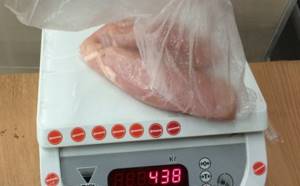
The average weight of one chicken will be 700 grams.
- The weight of fillet with skin, carefully separated from bones and joints, is approximately 500 grams.
- The weight of the poultry flesh without skin and bones is 450 grams. Half a fillet weighs 225 grams.
- The weight of fillet in 100 grams of such a breast is (450/700) x 100 = 64 grams.
- Weight of fillet from 200 grams of breast 64x2 = 128 grams.
- Chicken skin can be denser with a larger layer of subcutaneous fat.
- The pulp from the seed itself can be separated more or less carefully.
Calculations for each breast, even with the same weight, may differ. But using them, if the need arises, you can prepare tasty and healthy food from its fillet.

You will learn more about the properties of chicken breasts by watching the following video.
source
Calorie content of Chicken fillet. Chemical composition and nutritional value.
Nutritional value and chemical composition of “Chicken fillet”.
The table shows the nutritional content (calories, proteins, fats, carbohydrates, vitamins and minerals) per 100 grams of edible portion.
| Nutrient | Quantity | Norm** | % of the norm in 100 g | % of the norm in 100 kcal | 100% normal |
| Calorie content | 110 kcal | 1684 kcal | 6.5% | 5.9% | 1531 g |
| Squirrels | 20 g | 76 g | 26.3% | 23.9% | 380 g |
| Fats | 2 g | 56 g | 3.6% | 3.3% | 2800 g |
| Water | 75 g | 2273 g | 3.3% | 3% | 3031 g |
| Ash | 1.1 g | ~ | |||
| Vitamins | |||||
| Vitamin B1, thiamine | 0.09 mg | 1.5 mg | 6% | 5.5% | 1667 g |
| Vitamin B2, riboflavin | 0.14 mg | 1.8 mg | 7.8% | 7.1% | 1286 g |
| Vitamin RR, NE | 12.9 mg | 20 mg | 64.5% | 58.6% | 155 g |
| Niacin | 7.69 mg | ~ | |||
| Macronutrients | |||||
| Potassium, K | 266 mg | 2500 mg | 10.6% | 9.6% | 940 g |
| Calcium, Ca | 9 mg | 1000 mg | 0.9% | 0.8% | 11111 g |
| Magnesium, Mg | 24 mg | 400 mg | 6% | 5.5% | 1667 g |
| Sodium, Na | 66 mg | 1300 mg | 5.1% | 4.6% | 1970 |
| Phosphorus, Ph | 181 mg | 800 mg | 22.6% | 20.5% | 442 g |
| Chlorine, Cl | 77 mg | 2300 mg | 3.3% | 3% | 2987 g |
| Microelements | |||||
| Iron, Fe | 1.4 mg | 18 mg | 7.8% | 7.1% | 1286 g |
| Yod, I | 6 mcg | 150 mcg | 4% | 3.6% | 2500 g |
| Cobalt, Co | 8 mcg | 10 mcg | 80% | 72.7% | 125 g |
| Manganese, Mn | 0.02 mg | 2 mg | 1% | 0.9% | 10000 g |
| Copper, Cu | 80 mcg | 1000 mcg | 8% | 7.3% | 1250 g |
| Molybdenum, Mo | 11 mcg | 70 mcg | 15.7% | 14.3% | 636 g |
| Fluorine, F | 130 mcg | 4000 mcg | 3.3% | 3% | 3077 g |
| Chromium, Cr | 21 mcg | 50 mcg | 42% | 38.2% | 238 g |
| Zinc, Zn | 1.2 mg | 12 mg | 10% | 9.1% | 1000 g |
| Essential amino acids | |||||
| Arginine* | 1.51 g | ~ | |||
| Valin | 1.08 g | ~ | |||
| Histidine* | 1.1 g | ~ | |||
| Isoleucine | 0.94 g | ~ | |||
| Leucine | 1.65 g | ~ | |||
| Lysine | 2.19 g | ~ | |||
| Methionine | 0.37 g | ~ | |||
| Methionine + Cysteine | 0.73 g | ~ | |||
| Threonine | 0.92 g | ~ | |||
| Tryptophan | 0.31 g | ~ | |||
| Phenylalanine | 0.88 g | ~ | |||
| Phenylalanine+Tyrosine | 1.63 g | ~ | |||
| Nonessential amino acids | |||||
| Alanin | 1.08 g | ~ | |||
| Aspartic acid | 1.61 g | ~ | |||
| Hydroxyproline | 0.18 g | ~ | |||
| Glycine | 0.76 g | ~ | |||
| Glutamic acid | 2.35 g | ~ | |||
| Proline | 0.84 g | ~ | |||
| Serin | 0.84 g | ~ | |||
| Tyrosine | 0.75 g | ~ | |||
| Cysteine | 0.35 g | ~ | |||
| Sterols (sterols) | |||||
| Cholesterol | 10 mg | max 300 mg | |||
| Saturated fatty acids | |||||
| Saturated fatty acids | 1.17 g | max 18.7 g | |||
| 14:0 Miristinovaya | 0.03 g | ~ | |||
| 16:0 Palmitinaya | 0.9 g | ~ | |||
| 17:0 Margarine | 0.01 g | ~ | |||
| 18:0 Stearic | 0.21 g | ~ | |||
| 20:0 Arakhinovaya | 0.02 g | ~ | |||
| Monounsaturated fatty acids | 1.6 g | min 16.8 g | 9.5% | 8.6% | |
| 14:1 Myristoleic | 0.01 g | ~ | |||
| 16:1 Palmitoleic | 0.28 g | ~ | |||
| 17:1 Heptadecene | 0.01 g | ~ | |||
| 18:1 Oleic (omega-9) | 1.3 g | ~ | |||
| Polyunsaturated fatty acids | 0.61 g | from 11.2 to 20.6 g | 5.4% | 4.9% | |
| 18:2 Linolevaya | 0.53 g | ~ | |||
| 18:3 Linolenic | 0.03 g | ~ | |||
| 20:4 Arachidonic | 0.05 g | ~ | |||
| Omega-3 fatty acids | 0.03 g | from 0.9 to 3.7 g | 3.3% | 3% | |
| Omega-6 fatty acids | 0.58 g | from 4.7 to 16.8 g | 12.3% | 11.2% |
The energy value of chicken fillet is 110 kcal.
Primary Source: Created in the application by the user. Read more.
** This table shows the average levels of vitamins and minerals for an adult. If you want to know the norms taking into account your gender, age and other factors, then use the “My Healthy Diet” application.
health-diet.ru
How much does one chicken breast weigh?
I often buy chicken breast because chicken breast fillet meat is low in calories and can be used to make many delicious dishes. The weight of a chicken breast can vary from 400 grams to 1 kilogram, but I don’t like to buy large specimens - there is a lot of “waste” in the form of skin and bones. The most optimal weight is 600 - 700 grams.
The weight of a chicken breast depends on the size of the chicken itself. And the size of a chicken often depends on its breed, as well as where it was raised (at home or in a poultry farm). If the question is asked about chicken fillet from a supermarket, then its weight varies from 400 grams to 900 grams. This way you can calculate the average mass: (400+900)/2=650 grams.
As I understand it, the question is about chicken breast with bones and skin, and not about chicken breast fillet.
Of course, the weight of a chicken breast depends on the size of the whole chicken. There are chickens weighing a little over a kilogram, and there are specimens weighing more than two kilograms.
The smallest chicken breast I saw on sale weighed a little over half a kilogram. These small breasts are usually packed two per tray.
More often in stores with semi-finished chicken products you come across breasts weighing from six hundred to eight hundred grams.
I think the average weight of a chicken breast is about six hundred eighty to seven hundred eighty grams.
The weight of one chicken breast depends on the breed of meat chickens, the conditions of their keeping and feeding.
Therefore, it is difficult to even name the average weight of the fillet. And yet it is believed that the maximum weight of an ordinary adult chicken breast does not exceed 850 g, and the minimum is two hundred (including skin). And based on these numbers, then the average weight of one chicken breast is 525 grams.
We often buy a product such as chicken breast. I can’t tell you the exact weight, since it is always different. Chicken breast can weigh 800-900 grams, or it can be within 200 grams.
Manufacturers themselves regulate the weight in food trays. Because every buyer has different needs.

On average, one chicken breast, as I noticed, weighs about 800 grams, of course there are more and less, but the average weight of 1 chicken breast is 800 grams.
If you smoked a whole carcass and want to know how much 1 chicken breast will weigh in this case, then a hint will help you, which says how much the carcass itself weighs and how much the breast will weigh:
But, I want to remind you that the weight is given with the bone; without the bone, one chicken fillet will weigh 100-150 grams less (again, depending on how carefully you separate it from the bone). On average, half a chicken breast (fillet), if you simply cut it off (and not cut it from the bone), will weigh 200 grams.
source
How much does a chicken weigh, table of height and weight of broilers by day

When planning to start a business selling large quantities of chicken meat, you need to calculate in advance how much a chicken of a particular breed or variety weighs. This will help determine the number of chickens, feed and the approximate timing of receiving goods for sale. In the article you will find information about the weight of broilers and laying hens. You will learn how and when to weigh birds while raising them.
Why do you need to control your weight?
The body weight of chickens must be constantly monitored. This will avoid unnecessary expenses on the purchase of feed and additives. Why overfeed a bird that has already reached its weight limit.
It will be possible to stop adding nutritious feed in a timely manner. Before chickens develop obesity.
By monitoring your weight, you will be able to identify those from the herd who are not receiving enough nutritional supplements. After all, underfed chickens develop rickets, gout and other diseases.
By controlling the growth of chickens, you can simultaneously monitor their health. Sick birds refuse to eat and quickly lose weight. Knowing how much a broiler or purebred chicken should weigh at a certain age, you can promptly identify those who are sick.

How to correctly determine mass
To find out how much a broiler or purebred chicken weighs, use electronic scales, a steelyard, a regular bag or a cardboard box. Start by determining the tare weight. It will need to be subtracted from the total indicator on the scales.
A small chick can be weighed in a gauze bag with a tight bottom and handles. To weigh adult broilers, bags and burlap sacks are used.
To prevent the bird from twitching and creating disturbances, two holes are made in the bottom of the bag. The chicken's legs are inserted into them and fixed in a standing position, holding it by the body through the bag.
If the bird is restless and it is not possible to weigh it in a bag, use a cardboard box. Calmly behaved chickens are simply placed on scales and weighed.

What does weight depend on?
Variety: Given the same amount of feed, broilers weigh more than purebred chickens. This is due to the genetic characteristics of their body.
Productive focus: chickens are raised for eggs and meat. Representatives of any breed can cope with this task.
But the quality of the resulting product and its quantity also depend on the productive orientation or propensity of the chicken to produce and accumulate the product. Thus, the average weight of broilers is 3-4 kg, and egg-laying chickens are 1-2 kg.
Nutritional value of feed: if a bird does not receive all the nutrients necessary for its growth, then its weight will be less.
The weight of a chicken also depends on its age. So, day-old chicks weigh very little. But with proper care and feeding, they grow quickly and gain size.

Causes of failure to gain weight
Quality of feed and quantity of feeding: in winter, birds are fed three times a day. In summer, the number of feedings is reduced to 2 times. The low calorie content in feed has a significant impact on the weight of a broiler or purebred chicken. Food should be supplied to the feeders on schedule.
Improper growing conditions: Birds should not be kept in cramped, poorly ventilated areas with insufficient light. A large walking area also has a negative impact on weight gain.
Molting: Chickens may lose some weight during this time. Usually the change of plumage occurs in the fall. Therefore, there is no need to delay slaughter.
Diseases: Sick chickens lose weight quickly. Sometimes it is easier to slaughter a bird immediately after the disease is detected. This allows you to retain some of its productive value.
The reason for the insufficient rate of weight gain may be the characteristics of the species. Broilers gain weight faster than other chickens.
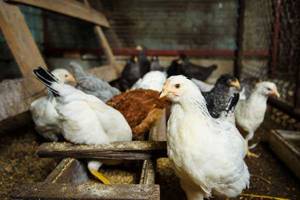
Problem solving and prevention
Rapid weight loss can be prevented.
There is a difference between winter and summer bird rearing. If you follow the rules, the chickens will gain weight as needed.
In winter, chickens are given grain, wet potato mash, grated beets, bran, chopped hay and silage, and grain waste. In the summer the chickens are released to graze. And they try to introduce more fresh vegetables and herbs into the daily diet. Chickens are fed 2-3 times more often.
Birds must have constant access to fresh water.
Daylight hours during molting should last up to 8 hours. After changing the pen, the daylight hours are increased to 13-14 hours.
Winter air temperatures should not fall below 5 degrees.
Sick chickens are separated from healthy ones and quarantined. The room is treated with lime and ventilated.
Accommodation rate: 3-5 individuals per 1 sq. m.
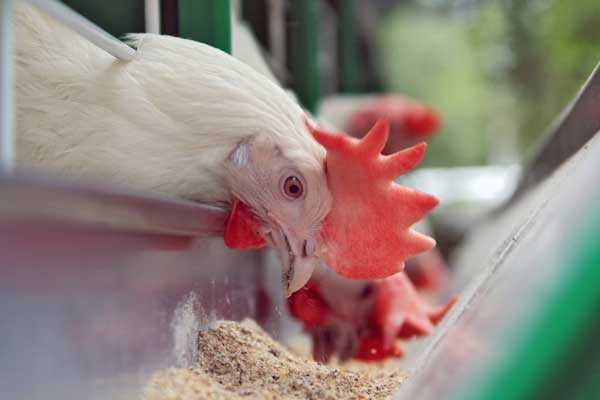
All about broiler weight
Dial speed and weighing nuances
The weight of broilers differs from the weight of purebred chickens at the same age. In the first 20 days of life, their weight increases 20 times.
A newly hatched broiler chicken has a body weight of 40 to 44 g. It is well built. Thanks to its powerful legs and thighs, the broiler looks stronger than chickens of other breeds.
1 day after hatching, another 10-15 daily weight gain will be added to 40-44 g. For more information about the rate of weight gain, read the article “How long does a broiler grow for meat.”
The weight of the bird is determined by weighing. The procedure is carried out daily or once every 10 days. At the same time of day, preferably before feeding. Extreme accuracy allows us to determine the effectiveness of additives introduced into the chicken diet.
It takes no more than 3 months to fatten broilers. After slaughtering 1 bird, it is possible to obtain from 2.5 to 3 or more kg of meat.
Broiler weight by day
The broiler growth chart will help you achieve positive results with less losses:
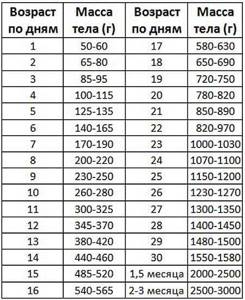
The table of broiler weights by day gives standard norms. Deviations of 50-60 g are acceptable.
We equalize the indicators and determine the average parameters
In order for the weight of the broiler stock to be approximately the same, the birds must be kept in the same conditions.
The optimal air temperature in the room where day-old chicks are kept is 30 degrees. When they reach 2 weeks – 25 degrees. At 1 month, the air temperature can be lowered to 20-18 degrees.
With intensive fattening of broilers, it is even possible to place 5-10 individuals in cages.
If there are a lot of chickens, then to determine the average weight, 10 individuals are selected from every hundred and weighed.
In this case, an error of 10% must be taken into account. It occurs due to the presence of both cockerels and hens in the livestock. Females weigh less than males by about 500 g. Their rate of weight gain is also slower.

Are extra pounds good?
If a broiler weighs more than normal at the time of slaughter, this is not very good. Because such indicators indicate obesity. Causes of excess weight:
- the presence of saturated fatty acids in feed;
- painful condition;
- consumption of feed in excess of the prescribed amount.
The presence of fat in the carcass reduces its consumer value. When cutting, the fat mass will have to be thrown away or processed.
Fatty meat contains large amounts of cholesterol, which is harmful to human health.
Information from the article “Feeding standards for broilers” will help you avoid problems.

Laying hen weight
General characteristics
The main purpose of raising laying hens is to produce a large number of eggs.
Good growth of broilers is achieved due to the high degree of digestibility of feed. Laying hens are more capricious in this regard.
Even when consuming the same feed as meat birds, laying hens rarely reach the same body weight. The reason is genetics.
Naturally, egg-laying chickens can also be slaughtered for meat. But it is more advisable to use them for their intended purpose.
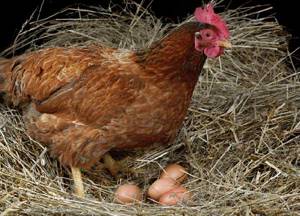
Dial speed and weighing nuances
A laying hen chick that has just hatched from an egg weighs on average 25-35 g. During the day it gains 5-6 g. After 10 days, the weight of the chicken is 60-90 g.
A sexually mature laying hen weighs from 2.5 to 3 kg. It reaches this mass in 5-6 months.
Laying chickens are weighed on average once every 10 days.
In small farms, the weight of the chicken is determined immediately before slaughter. But on poultry farms, laying hens are weighed to determine the reason for the lack of the required number of eggs.
This information helps to understand whether the bird is receiving the required amount of nutrients. Find out what effect a changed nutritional diet has on her. And also, is the chicken sick?

Weight gain
Whether the hen is gaining weight correctly is determined based on the table:
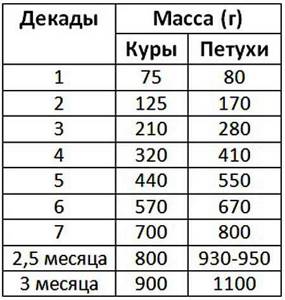
As can be seen from the table, the weight of a rooster is greater than that of a chicken. The thing is that males increase in size faster than females.
Reasons for slowing down weight gain
The first eggs can be obtained from laying hens when they reach 4.5-5 months. Before egg work begins, they may stop gaining weight.
This is normal. But you shouldn’t feed the chicken less. During egg laying, laying hens require special nutrition. What is described in the article “What should you feed laying hens so that they lay a lot.”

Let's sum it up
Controlling the weight of chickens raised for meat or eggs is essential. Timely information about changes in poultry weight allows you to avoid production losses. And also prevent the development of serious diseases.
It is also useful to control egg mass. Find out why in the article “How much do chicken eggs weigh by category.”
If you are interested in the article, please rate it 5 stars.
Leave comments - your opinion is important to us. By sharing an article with friends on social networks, you will find interlocutors.
znaipticu.ru
How profitable is it to buy chicken breast with or without bone?
I bought a chicken breast with a bone, the price was 209 rubles. /kg. 0.688 g for 143.79 rub. I separated the bone, weighed 100 g. Without the bone, the price is about 300 rubles. /kg. Approximate price bone-in without bone is 245 rubles. / kg. If you calculate correctly, it is profitable to buy with a bone.
No duplicates found
Buy a whole chicken, cut the breast and compare the benefits.
I didn’t have time))) They took it right off my tongue)))
Do some more research to see what is more profitable to buy: washed potatoes or dirty ones.
fried, but unwashed - it’s cheaper
It is profitable to buy whole. And if you also steal it, the benefit is obvious.
208 with bone? Oh my goodness. I buy a bk filet for 220.
You are making the assumption that the meat/bone ratio will continue to be this way.
I once did a calculation on oven-fried chicken. I took fillet, thighs and drumsticks. In terms of the weight of pure meat without bones, the drumsticks were not much, but much cheaper. Then the thighs, lastly the fillet.
not by much, but much cheaper
Somewhere between warm and hot.
You can also cook some broth on the bones.
You separate the bone and make a broth. When it’s ready, you can chop a little more meat from it and fry everything with onions (do not add salt) and everything you have. Then put everything in a dashik and pour it with the broth in which the bone was cooked. Meanwhile, slice the breast thinly, make a batter and fry it. For the first course, delicious doshirak, for the second course, brisket in batter. Cat bone..PROFIT.
Well, it’s clear that the person lived/is living in the dorm. As they used to say: respect and respect!
I remember, for example, that if you boil dumplings in the same water three times, then on the fourth you can simply add pasta. And it will also be gluttonous.
Those. Don’t you consider it a waste of your time to remove the bone?
These Muscovites are completely greedy. Fillet 300 rubles per kilo
What does it have to do with fucking Muscovites.
despite the fact that you're kind of nervous. By any chance, do you have a skitelstryanka?
What? And why am I nervous? I just asked why you came to the conclusion that this is a Muscovite.
This may upset you, young man, but I didn’t draw any conclusions
I haven't been called a young man for a long time, it's nice!
Did you just fuck off like that?

Yes, we need to understand the depth of our depths.
About the community
Remember that under someone else's nickname is hiding the same person as you. Failure to comply with this rule will result in a 2-week ban.
The user is personally responsible for compliance with the legislation of the Russian Federation of the information he posts on the site, its purity from claims of third parties. Our League is about food, so let's talk exclusively about it
source
Chicken thighs are a great alternative to dry breasts
All those losing weight firmly believe in the benefits of chicken breast/fillet. I won’t lie if I assume that there are thousands and thousands of recipes on the Internet like “how to cook chicken fillet so that it doesn’t become dry and stick in your throat during a long diet.” Meanwhile, not everyone manages to cook fillet as in these recipes and it really gets boring quickly.
For a while I had nightmares about fillet. And I even stopped cooking it for future use. That is, now if I plan to eat fillet, I take one or two pieces out of the freezer and cook it just before eating. For example, I fry two pieces on the grill and my husband and I immediately eat a portion. I can still handle the fillet hot and fresh, but if it sits in the refrigerator and is heated, then for my taste it’s like cotton wool. What's cool about it?
And I thought, what if I don’t look for fillet recipes, but look for parts of the chicken that can be tastier and easier to cook? And I found it!
The benefits of chicken thighs
Chicken thigh is my answer to all ills. Well, not from everyone, of course, but it will definitely solve the problem of dry fillet. It’s easier to prepare it this way, and it has much more benefits. The thighs contain a whole bunch of useful substances and vitamins. If you eat chicken thighs regularly, you can solve a bunch of health problems, including improving your metabolism.
Yes, the thigh is higher in calories than the fillet, it is considered almost the most high-calorie part of the carcass, but my daily norm is high, you know, right? so the caloric content doesn’t bother me:
- in boiled chicken thigh – 185 kcal,
- grilled chicken thigh – 200 kcal,
- fried chicken thigh is 243 kcal,
- chicken thigh stewed in sour cream – 220 kcal.
It is believed that thighs should not be overused because they contain a lot of fat.
But! This same fat contains all the benefits of the thigh. Moreover, there is not so much of it, the composition is as follows: proteins - 21.3 g, fats - 11.4 g, and carbohydrates - 0.1 g.
I'm a big fan of healthy fats.
, I believe that all women’s (and men’s too) health rests on them. Therefore, when considering daily CBJ, I would rather abuse fats than proteins and carbohydrates. And that's why thigh is my favorite chicken meat.
Chicken thigh: 109 calories
Chicken thigh is slightly more tender and flavorful than chicken breast due to its higher fat content.
One cooked skinless, boneless chicken thigh (52 grams) contains (2):
- Calories: 109 kcal.
- Protein: 13.5 g.
- Carbohydrates: 0 g.
- Fat: 5.7 g.
A 100 gram serving of chicken thigh contains 209 calories, 26 grams of protein and 10.9 grams of fat (2).
Thus, 53% of calories come from protein and 47% from fat.
Chicken thighs are often less expensive than chicken breasts, making them a good choice for anyone.
One chicken thigh contains 109 calories, or 209 calories for every 100 grams. Calories come 53% from protein and 47% from fat.
How do I cook chicken thighs?
I cook a chicken thigh, which is probably considered boiling or stewing. I prepare it like this:
Place it in a deep frying pan
, I pour some water. I don’t add oil, the thigh is already fatty. I put whatever herbs I have on hand. Now basil, parsley, and celery come into play. I can throw in a carrot or onion for flavor. Salt is a must (I don’t think salt is harmful and everything tastes good with it. I know that many foods are tasty without salt).
Well, here we go. And then I put it out
Cover for 20 minutes, turn over once. And that's it, ready. It turns out delicious, fresh, tender meat, healthy fat. Omnomnom?
With pasta
Meat is considered to be served incorrectly, but I don’t give a damn about the rules, you know. Moreover, I don’t plan a menu (I’ll write about this sad fact someday), so if I find pasta in the refrigerator, I’ll eat it with chicken, I’m not ashamed.
But chicken meat goes amazing with vegetables
- boiled, stewed, fresh. I already wrote that in the summer I hardly cook vegetables. Salads, just whole vegetables are my everything.
Makes a great lunch or dinner. One thigh can even be a snack during the day or evening.
Boneless chicken thighs
By the way, relatively recently I made an amazing discovery - boneless chicken thighs are sold in stores. That is, chicken thigh meat or thigh fillet or something. The bone was carefully removed from it and you can cook pilaf, shish kebab, and some other dishes. But I still buy it with bones - I need to treat the village cats when they come to visit. I am not kidding

